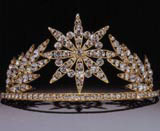The head set
The tiara, ornamental headgear of royalty and brides, is being celebrated in an exhibition at the V&A. Nick Smurthwaite went along

Once the must-have accessory of every society hostess, the tiara was reduced to a kitsch joke thanks to the likes of Wonder Woman, Victoria Beckham and Elton John. But a new exhibition at the Victoria & Albert Museum reveals the artistry and inventiveness that’s gone into the design of these quasi-crowns over the centuries.
The word tiara is Persian, meaning a high-peaked head-dress, as sported by Persian monarchs. Even before the advent of metal, the ancients made garlands and wreaths from flowers and foliage. Think of Caesar’s laurel wreath and Christ’s crown of thorns.
In England the custom of brides wearing jewelled head ornaments was well established by the 15th century. Crowns were no longer regarded as the exclusive right of royalty, but as a symbol of the dignity of wedlock. In modern times, the most celebrated bridal tiara was probably that worn by Lady Diana Spencer when she married Prince Charles. So dazzling was the Spencer family trinket that it even survived the visual eclipse of that unforgettable meringue of a wedding dress.
The tradition of bridal headgear, says Geoffrey Munn, who has written the sumptuously illustrated book accompanying the exhibition, is rooted in the symbolic representations incorporated into the design. Acorns betoken fecundity, daisies innocence, and so on. So the combination of an acorn and a diamond, which symbolises constancy, could be interpreted as ‘forever fecund.’
Since many of the most elaborate and valuable tiaras have been commissioned and owned by royalty, it’s no surprise that a number of them are in this show. We learn that Queen Victoria’s husband was no mean jewellery designer himself, and that Queen Mary would never dream of sitting down for dinner without her tiara in place.
Though the coronation of George VI in 1937 was a boom time for tiara designers and makers, the post-war period saw a marked decline in their popularity. Once-wealthy families sold them off, and many were broken up to make single-stone engagement rings.
Munn attributes the tiara’s rehabilitation in the 1980s to the late Paula Yates, who adopted it as an ironic fashion statement, wearing costume tiaras with denim jeans or miniskirts. Likewise fashion designer Vivienne Westwood used to be seen cycling around London wearing an assortment of brightly coloured plastic tiaras.
For her wedding to Guy Ritchie in 2000, Madonna sported a late 19th century tiara set with diamonds weighing 78 carats – more kosher than kitsch – and they seem to have become a popular accessory with the Hollywood set in recent years. Some of the contemporary tiaras on display by the likes of Wendy Ramshaw, Jan Mandel, Philip Treacy, Jan Yager and Tim Gosling are every bit as striking as their early counterparts and a good deal more original.
Gosling’s carved beechwood tiara, for David Linley Furniture, and Treacy’s Medusa-like feather and crystal creation are truly innovative pieces. The notion of ‘transformer’ jewellery that can be turned from a tiara into a necklace, brooch and earrings invites further ingenuity from these talented innovators.
Tiaras Past and Present is at the Victoria & Albert Museum until 14 July. A Tiara Ball will be taking place on Friday 29 March. Arrive wearing a tiara and entrance to the exhibition is free (contact the V&A box office on 020 7942 2209). Geoffrey Munn’s book of the exhibition is available from V&A books at £12.95
-
Post a comment



